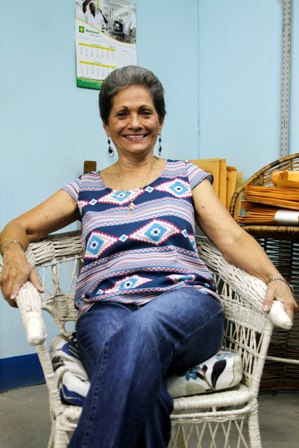Florence Celcis, an exceptional glassworker
 As part of our series of portraits of students and craftsmen of the on-site school of the Gingerbread project, Nouvèl FOKAL presents a woman who has worked on the finishing touches of the Dufort House: Florence Celcis. Experienced professional glassworker, she made fifteen lampshades and wall lamps for the home. She works in several areas: Religious stained glass, lampshades, decorative stained glass, stained glass heritage restoration and much more. Nouvèl FOKAL visited her workshop to discover her fascinating universe.
As part of our series of portraits of students and craftsmen of the on-site school of the Gingerbread project, Nouvèl FOKAL presents a woman who has worked on the finishing touches of the Dufort House: Florence Celcis. Experienced professional glassworker, she made fifteen lampshades and wall lamps for the home. She works in several areas: Religious stained glass, lampshades, decorative stained glass, stained glass heritage restoration and much more. Nouvèl FOKAL visited her workshop to discover her fascinating universe.
Her hands bear the weight of years. Her face reflects her years of experience. Like any craftsman practicing in Haiti, she has experienced "hard knocks". But it was with a smile that Florence Celsis welcomed us into her workshop located on Paul Moral Street in Cité Militaire.
Born in Jacmel, Florence Celsis married to the engineer Georges Celcis, is the mother of two daughters,. After living in the United States, Florence moved to Haiti in 1970 then opened a business called Celex a few years later.
The workshop is divided into three parts. First a fairly large office space to accommodate a lounge, accounting desk and a large work table where Florence welcomes her guests and customers. It is on this table that she draws stained glass patterns. Next, the installation space, where cutting, welding and molding are done. Finally, a tool room. In her office hangs a certificate from the President of the Republic given for "her talent, expertise and her significant contribution to the promotion of Haitian craft."
In the lobby where her team works at the assembly of cut pieces are tables with lampshades and other items in the making, shelves containing glass shards, a cabinet, a pressure machine dating from the heyday of the workshop, a pattern cutting machine ... everything is there.
An amateur beginning quickly became professional
"My husband and I lived in Boston before returning to Haiti. In 1974, a friend, John Waite, offered to return to Haiti to teach us how to make Tiffany lampshades. I did not even know the Tiffany style at the time. She admits that in her debut in the profession. "It was with great effort and perseverance, that we got into it, before making our first lampshade ..."
It did not take long for her activity to gain a foothold. In 1977 she got her first contract with an American firm after three years of mastering her technique and innovation: delivering 2000 shades every five to six weeks. They were the heydays. More than 250 employees were busy in the workshop which was for 30 years in a larger space, across from its current location. "We shipped to the United States a 40 foot container. It was the great production. " She says. But the US embargo on Haiti in 1991 made it all crash.
Florence’s facility operated at slow pace, like many other sectors of the national economy, and finally she lost the contract with the American company and her 250 employees. Today they are only four employees. From the production of lampshades, Florence went on to the manufacture of stained glass windows in 1992: the first stained glass window was that of the funeral home of her family, L’Ange Bleu of Turgeau.
Stained glass, a sacred art
Her transition to the manufacture of stained glass windows intensified with orders from different churches. The first church was the Calvary Baptist Church of Chartres in Port-au-Prince. After seeing the stained glass of the Blue Angel. "Monseigneur Laroche who built the Cathedral of Hinche at that time, saw the window of this Baptist church, and made inquiries with the pastor. Thus he came to us to order a stained glass window for the cathedral ... and the rest is history.» Florence said.
To date, more than 26 churches in the country have stained glass windows bearing the signature of Florence Celcis and her employees. "The latest works that we made are those of the new small cathedral of Port-au-Prince funded by an Americans: they are seven feet wide and ten feet high."
The stained glass window is considered a sacred art because of its strong presence in churches. Many temples and cathedrals of the world are thus decorated. The city of Chartes in France is considered the capital of stained glass. In Haiti, Florence Celsis is part of the last artisans of stained glass windows, which radiate beauty in our churches and enrich their architecture.
The same materials are used to make stained glass windows and lampshades but the techniques are different. In addition to its aesthetic appearance, a window fills multiple functions, while the lampshade, either conical or cylindrical, softens the light from a bulb.
Making a lampshade or stained glass window takes patience and care
Renio Laurent, one of four shop employees, was putting the final touches to shades for FOKAL during the visit; it was at the stage of the final welding.He has been 38 years in the business. Florence took the opportunity to explain the processes of manufacture. She asked Victor Rony, another member of the team (35 years in the workshop), to make a small demonstration of the twenty-year-old high pressure machine.
Whether for the stained glass windows or lampshades, Florence and designer Bertony Sixteen begin by the preparation of the model. Then, the templates are cut into panels with special scissors.
The glass pieces are often cut by hand. "First, we cut the glass pieces. They then go to the grindstone to remove the rough edges. They are placed upside down on the template. Then, they are coated with a copper tape.» she says.
Once all the parts are welded together, we mount the panels on a template, then we weld them to each other. "For the finishing stage, we wash and sulfate junctions to blacken the metal." The metals used are copper, lead or zinc (especially for the stained glass windows).
For stained glass, each piece is surrounded by a rail and the final product surrounded by a zinc angle "to give it strength."
"It's an exciting job that I love, '' she admits.
Florence’s team includes: Victor Rony, Renio Laurent, Joseph "Jocelyn" Bido (the assistant manager) and designer who is on contract. Bido Joseph admires the "technical ability of Florence" after 34 years of collaboration. For Rony, "Florence is a person open to discussion. She never raises her voice at us. "
An uncertain succession
Besides the artistic taste, you have to be able to draw and paint, know the techniques of glasswork, have imagination, have patience, precision and a sense of volume. Qualities her team masters, but Florence hopes one day to transmit to the next generation...
However, Florence is skeptical: "When people ask me, where is the next generation ... that is the question that troubles me. It is a tiring job. To train a new worker, takes several years. This is a very meticulous job," she said. Neither the children of Florence, nor the children of Renio and Rony are interested.
But at some point, ‘’What will you do? we asked "Close." she said after a moment of silence.
Yvens Rumbolt



